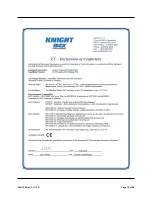
0901133 Rev: A (11/13)
Page 5 of 20
CUT RESISTOR
TO USE COM A
FOR PUMPS
AND COM B
FOR PUMPS
R2
1, 2
3, 4, 5, 6
R1
1, 2, 3
4, 5, 6
R4
1, 2, 3, 4, 5
6
PRE-INSTALLATION
Before the equipment is installed, you should survey the
installation site thoroughly. At the very least, your survey
should include the following:
Check to make sure that all functions of the
washmachine are operating properly. Including; card
reader or timer, water solenoids, flush down valves,
water level switch, machine motor, and drain valve.
Check the proposed location for a 100 to 240 VAC
power source.
Check voltage of all supply signals that will be used
from the washmachine. Measure voltage between
supply signal and signal common with a voltmeter.
DO NOT check signal voltage between supply signal
and case (earth) ground.
Measure the distance from chemical supply
containers to pump housing, and from pump housing
to injection point inside washmachine.
INSTALLATION
(1) Disconnect all power to washer.
(2) Mount pump cabinet in a convenient location no
higher than 8’ above, and within 10’ horizontally, of
supply containers. This is usually near the washer,
however dispenser can be mounted as a remote
pumping system.
(3) Using the provided mounting bracket, mount the
Remote Control
to the front of the washer where
operators can easily access it. Secure the bracket
to washer using provided mounting screws or Dual-
Lock fastening strips (be sure to first clean the
mounting surface as the adhesive will not stick to a
dirty surface). Connect the low voltage cable from
the remote to the pump cabinet.
(4) Connect 100 to 240 VAC power source to main
power connection in pump cabinet. Use suitable
conduit for electrical wiring (per applicable wiring
codes). NOTE: Low voltage cables do not require
conduit.
(5) Install and wire the
Signal Interface Module
(SIB)
per notes to the right.
(6) For each pump, cut the suction tube to length and
insert one end into the appropriate supply container
using PVC pipe as a support. Insert other end of
suction tube into the left (input) side of the pump’s
squeeze tube.
(7) For each pump, cut the discharge tube to length
and insert one end into the right (output) side of the
pump’s squeeze tube. Form an anti-siphon loop
(pointing ―down―) with the other end of discharge
tube and insert into the supply pocket of the
machine.
(8) The system is now ready to be powered up and
programmed.
The Signal Interface Module (SIB):
The SIB receives supply signals from the washer, then
communicates with the dispenser to run the pumps. The
low voltage cable allows a quick, clean connection from
the module to the pump system without requiring
conduit.
(1) Mount the module using the provided Dual Lock
adhesive strip. The module can be mounted inside
the washer’s controls, along side the washer’s
controls, or to the bottom of the pump cabinet.
(2) Connect the low voltage cable from the module to
the OP-Pro pump system.
(3) Connect the supply signals to the SIB per wire
colors on the SIB label. If using Drain Mode, only
one signal is required (pump #1).
(4) If you have one signal common (typical) connect
the common to ―COM A‖ on the SIB. If you have
two signal commons, you will need to remove a
resistor inside the SIB before connecting the
common wires! See the following details.
Splitting signal commons:
(1) Remove the four screws from the bottom of the SIB
to open the module.
(2) Locate the three resistors marked R1, R2, and R4,
on the left side of the module (each resistor has a
single black band).
(3) Cut and remove the resistor that will ―split‖ the
commons between the desired pumps. Be sure to
remove only one resistor.
(4) Close the module and replace the four screws
when finished.
Summary of Contents for Knight On-Premise Pro
Page 1: ...0901133 Rev A 11 13 Page 1 of 20 On Premise Pro Instruction Manual...
Page 16: ...Page 16 of 20 0901133 Rev A 11 13 SYSTEM WIRING DIAGRAM...
Page 17: ...0901133 Rev A 11 13 Page 17 of 20 SYSTEM PARTS DIAGRAM...
Page 18: ...Page 18 of 20 0901133 Rev A 11 13 SYSTEM PARTS DIAGRAM...






































